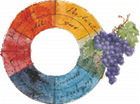Case Studies and Applications of Biodynamic Winemaking: Sangiovese and Dolcetto, from Vineyard to Cellar
By Leonello Anello, agronomist, consultant and researcher, director of the Section of Biodynamic Agricultural Sciences.
Modern biodynamics is the natural evolution of biodynamics, which originated in 1924 from the postulates of Rudolf Steiner. In his synthesis, Steiner connected us with the thinking and practices that preceded scientific knowledge, allowing us today not to forget about 10,000 years of human agricultural history. What happens in biological systems where variables are continuous and interconnected, making them difficult to separate and measure? Is there a difference between a physical phenomenon, which is measurable and repeatable, and a biological one, where each living organism does not respond to a single model?
Wine is a very complex substance, composed of several thousand components of which only a very small portion is known (often empirically). The holistic science addressed by modern biodynamics seeks to understand the living system in its complexity. Analytical simplifications, numerically represented, of complex interaction phenomena between the wine’s component substances and the living organisms that transform grapes into wine, are not scientific knowledge. Cabernet Sauvignon grapes were vinified in a comparison between modern biodynamic winemaking and conventional methods. The same was done with Dolcetto grapes. Regarding Sangiovese, the author reports a study on the characteristics and peculiarities of wines from three Tuscan areas, obtained from grapes cultivated and vinified according to modern biodynamic techniques.
I would like to thank everyone who participated and made this initiative possible, as well as all the speakers for their valuable contributions. I want to clarify what we intend to organize in this venue: to repeat these moments of gathering and dialogue between different “scientific truths” and to establish a place for ongoing education in the field of biodynamics, positioning ourselves as a platform for cultural exchange and presentation of concrete scientific findings, regardless of the belief system that inspires us—whether holistic or mechanistic. I emphasize that for us practicing biodynamics, it is important not to isolate ourselves, thinking we hold the sole truth; events like this allow us not only to engage with those who think differently, but also to demonstrate, through the concreteness of the studies and the wines we present, that we are not dealing with a speculative philosophy, but with a concrete way of acting and producing.
Biodynamics was born in 1924. The wines you tasted today are from 2005, 2006, 2007, and 2008, and they represent what has happened from then until now. Therefore, we are talking about a reality that we will seek to demonstrate scientifically, but that you have already experienced as real through your taste buds. I speak of modern biodynamics because modern biodynamics is the natural evolution of the biodynamics that began in 1924 and represents the most advanced practical application of Steiner’s postulates. While continuing to investigate and experiment, modern biodynamics avoids spreading anything that has not yet been verified and demonstrated. Steiner was not an agronomist nor a farmer; he was the one who, in some way, connected us with the thinking and practices that preceded scientific knowledge. This means about 10,000 years of human agricultural history. Here, in this hunting museum, you see scenes and tools from when humans were forced to “chase after prey.” At first, humans were hunters, able only to focus on procuring food; then, as farmers, they were able to “settle” in one place, cultivate it, and begin to think. This transition dates back at least 10,000 years.
Human knowledge from that era until about 400 years ago is what Steiner taught us, which coincides with the evolution of the human being. In the last 400 years, we have made great progress, but without what came before, we probably wouldn’t even be here today discussing these topics. We speak of biodynamic science, adding the term “science of the spirit.” Without prejudice, this does not mean we have confused scientific matter with religion; rather, we simply affirm that in human actions there is an essence that differentiates humans from all other living beings, and we identify this essence in their spiritual consciousness, in their self-awareness. For us, science does not exist without the involvement of the human being as a spiritual entity—not as emotion or feeling, but as spirit.
It is important to consider that until Galileo, nature was described in qualitative terms. Aristotle allowed the transmission of the qualitative description of nature to the world, making common the concepts of form and substance in describing natural processes—terms that we still draw upon in biodynamics today.
Subsequently, with the modern age, the description of nature became quantitative. This means that, starting from Pythagorean philosophy, knowledge was transformed into numerical representation. Today, official mechanistic science represents phenomena numerically, building upon and giving scientific form to Pythagoras’ intuitions—one of the first esoteric thinkers. Some scientists of questionable reputation today do not concern themselves with whether Steiner said important things or not, but only with whether he was an esotericist; Pythagoras was an esotericist, and none of you today would dispute his knowledge or what he allowed us to understand, simply because he was esoteric. In the same way, Rudolf Steiner’s statements must be evaluated based on their content. We pose questions regarding dominant scientific knowledge.
Science aims to understand and explain everything around us, and it can do so in various ways. Is it limiting to assert that scientific reality, to be considered such, must be measurable and repeatable? Does seeking cause-and-effect relationships make sense even in biological phenomena? Physics studies only what is measurable—does that mean that what is not measurable simply does not exist? Mechanistic science requires isolating phenomena and studying them individually; complexity is difficult to grasp. Is it difficult to represent something complex numerically?
What happens in biological systems where variables are continuous, interconnected, and difficult to separate and measure? Is there a difference between a physical phenomenon, measurable and repeatable, and a biological one, where every living organism does not follow a single model? Furthermore, human history is marked by the denial of certain phenomena at one time and their subsequent recognition only later. Who can deny that the immobile Earth at the center of the universe represented the truth for millennia, and how everything was revised—from theory development to everyday life—when it was “discovered” or rediscovered through accredited texts that the Sun was stationary and the Earth revolved?
We can therefore reasonably affirm that today, the lack of knowledge of certain phenomena and the functioning of living systems does not represent an absolute limit but only a temporary ignorance that should not become a rationalist deadlock. In this new way of considering science, biodynamic knowledge can certainly be considered a valuable resource. In mechanistic science, models are simplified and narrowed, and variables that hinder interpretation are reduced. But this is a great limitation, especially in the study of complex biological mechanisms where interactions within the living system are far more important than individual functions. The study of plants and wine clearly exemplifies this forced simplification. Wine is a very complex substance, composed of several thousand components, only a very small portion of which are known (often empirically); moreover, the countless interactions between known and lesser-known substances are still poorly understood.
Yet in winemaking practice, recipes and vinification protocols are used. An evident paradox: when most of the wine’s constituent substances are unknown, and most of the interactions between these substances are also unknown, how can procedures and protocols be defined to manage and produce wine? The result is a simplification of a complex and little-understood substance, producing a beverage based on wine. The holistic science that modern biodynamics deals with is a science that seeks to understand the living system in its complexity. A living organism is not merely a composition of cells. Our interpretation is not atomistic; it is a living entity which, as mentioned earlier, once broken down, can no longer be understood.
In the case of wine, modern biodynamics considers that, lacking total knowledge of its constituents and being unable to apply knowledge of hydroalcoholic solutions to living systems containing billions of microorganisms, altering their relationships and simplifying their synergies is at least short-sighted. Therefore, we approach the whole wine system holistically, and to manage it, we proceed through the “guidance” of the NATURAL ELEMENTS that govern the processes producing the wine. We support the wine’s development by governing the etheric forces that produce the metamorphosis of grapes into wine, reaching an intimate relationship with this living organic matter through sensory perceptions. This latter aspect means that, while making wine, we continuously observe, smell, and taste it to understand what to do.
We cannot SIMPLIFY living systems to derive globalized recipes. What has just been stated expresses the opposition between two conceptual approaches to knowledge to transform it into practical actions. Nothing here should suggest a criticism of one method to assert the superiority of another; rather, it must be clear, even to the consumer, that there are different ways to operate to obtain a wine or a beverage based on wine.
The Glories method, which is used to determine the extractability of anthocyanins, has proven to be unreliable; we have been saying this for many years, and today even renowned scientists are questioning it. Because the simulation of what is the extractability of certain substances from grapes into wine has turned out to be only a simulation. Relying on this method to determine the harvest time in the laboratory has been a failure and has led to the consequences of chimerical phenolic maturations with the production of wines with extremely high alcohol content. Analytical simplifications, numerically represented, of complex interaction phenomena of the substances composing wine with living organisms that transform grapes into wine ARE NOT SCIENTIFIC KNOWLEDGE. Enclosing living systems in dynamic evolution within models can mean distorting the essence of the obtained product. Certainly, we will be able to deepen these topics in other forums and future conferences. One of the purposes of these moments of meeting and confrontation between scientific paradigms is also to clarify terminology, and on our part there is the responsibility to be clear and understandable in communication. We have our own language, biodynamic science has its own language. We also have our own analytical evaluation systems, which must be made known and compared with the results of conventional analytical systems.
We have our own agronomy; we have our own botany; we have our own plant physiology, etc. Certainly, our idea of the plant is not that of a collection of tissues and organs, as studied at university, which is perfectly fine from a mechanistic point of view and is fine for theorizing its functioning; for us, the plant is a complex entity that in its individual parts does not hold the secret of its being alive, but only represents in its entirety the form in which the vital force of the cosmos “condenses” on the earth. For us, the plant is a collection of bodies. This does not mean that one should not know the plant also in its anatomical and physiological components to work in biodynamics, but exclusively applying mechanistic knowledge to biodynamic work leads to an approximate, confused approach and no results.
For us, a plant is not only what is written in botany and physiology books — it is something more. We divide the belonging to the world into four kingdoms: a mineral kingdom, a plant kingdom, an animal kingdom, and a human kingdom. Moving from the mineral kingdom to humans, the complexity of organisms increases, and in relation to the evolutionary appearance of members of these four kingdoms, there is an increasing presence of a successive “body” that disposes qualities of consciousness up to the highest level of evolution represented by the spiritual human being conscious in every action.
For us, a plant, at a first level of mineral complexity (physical body), adds a first level of vital being, the etheric or vital body. We have a first level, which is the physical body level, that all living organisms have, and therefore the plant has it as well, and it is the most mineral part of it; in all living systems, the physical body exists. One becomes a vital organism at the moment another entity appears — the one we spoke of before — which gives life to inorganic components (minerals) and transforms them into organic components: this entity is the vital body, or ETHERIC BODY.
For us, a plant is made of this. The energetic part that represents being alive, through which we interact to govern cultivated plants and reach the expression of a certain physical form. There is a third component, the ASTRAL, which is linked to the animal kingdom and envelops the plant from the outside; for now, I will only make a quick reference to it so as not to weigh down the explanation and to get more directly to the part about wine.
We derive our knowledge of nature from the way the four elements act. They are simultaneously present in the world around us and work in pairs. Generally, any exemplification is limiting: let’s say they work in pairs and represent the state of matter, how matter can present itself, both animate and inanimate. This knowledge is ancestral in the world and has enabled human history. Biodynamics teaches us to recover it and allows us to understand and evaluate the reality we observe in the vineyard or in winemaking with an active direct perception that cannot be replaced (objectified) by analytical evaluations made in a laboratory perhaps hundreds of kilometers away from our vineyard.
To each element — fire, air, water, earth — corresponds a subtle force that we call ether, which opposes a measurable physical force; from the combinations of these triads (physical force – element – subtle force) and from the relationship between the four elements arises the substance of which, for example, the cultivated plant is made, and therefore its form that tells us everything about its relationship with vitality and what we have done with our actions as farmers. In the case of air, it is light, extremely important for the vineyard and then for the wine: the grape ripens with light, not with the sun. Some scientific research confirms this, through placing grape clusters attached to the plant before veraison in dark paper bags or in transparent glass chambers but hermetically sealed. In the first case, the plants — especially pinot noir — were able to complete their ripening (veraison) calmly, therefore even without direct contact with sunlight, but with the air that could penetrate the paper bag. In the case of the glass bell, the cluster, although illuminated by the sun, but without contact with the air, remained in the pre-veraison phase.
This has been known since 1924. For ten thousand years, man has known it; mechanistic science, on the other hand, is only now coming to realize it and asks: how come? Wasn’t the sun supposed to ripen the grapes? We maintain that in the air there is the ETHER OF LIGHT “within” a natural element, which is air. Heat is another fundamental natural element for wine — the heat that ripens the wine in the barrel; whereas, conversely, physical heat burns the grapes, making them raisined, incapable of maintaining their presence and turning them into oxidizable wine.
Our language expresses concepts that I do not expect to be immediately accepted, but that intend to suggest how there is a scientific path to be undertaken to understand what is done in biodynamics. I conclude my speech by speaking about biodynamic wine, outlining some general concepts and referring to some applied scientific research works on which we have worked in recent years. Even in the cellar, one can work with ELEMENTS and ETHERS. Those who truly know biodynamic science know what we are talking about. Those who think that biodynamic grapes are brought into the cellar and the wine makes itself have no knowledge of biodynamics or at least of the Dynamic part of the term.
There are two fundamental elements for the metamorphosis of wine: the element water is only secondary. These elements are air, therefore the ether of light, which means what represents the subtle energy of air, and the ETHER OF HEAT, subtle energy of the fire element. These are the two elements on which we must work to produce wine. And this implies a series of precautions and choices. It means using air and not oxygen, because oxygen is a substance that acts in the opposite way to air: anyone who has been underwater knows what it means to have tanks filled with oxygen or tanks filled with air. Aerating wine is one thing; oxygenating it is another. Just as modifying temperatures, acting on physical heat — material energy opposed to the ether of heat — produces effects and reactions that undermine the vitality of the fruit. Controlling temperatures before and during fermentation also alters the balances of microbial populations in addition to modifying the work of the elements that sculpt and define the wine. These are just some of the implications. Knowledge of the elements guides us through all stages of transformation, including the choice of material used to build the vat.
In this regard, we are in favor of wood, which is also fire but contains air, and we are against terracotta, which is purely physical fire, and indeed it cooks and oxidizes the wine. We are in favor of cement, of limestone; we are absolutely against steel. To make good biodynamic wine, one must be guided by the knowledge of the world of elements and not by what sells best to the glossy-paper audience. The wine we produce must also satisfy the quality parameters indicated by our types of analysis, and the following is an example:
Two Cabernet Sauvignon wines, in comparison.
WINE A: is a biodynamic wine
WINE B: is made following a conventional protocol.
Both come from biodynamic grapes.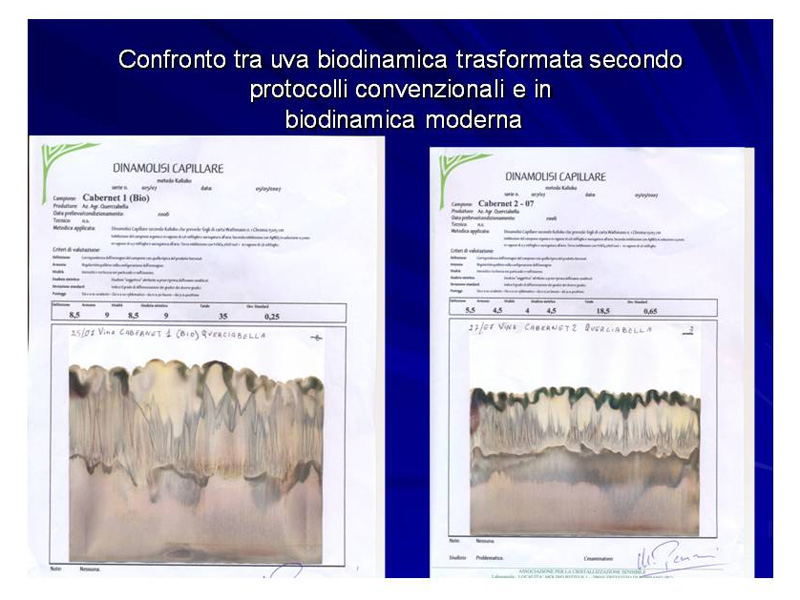
Figure 1
With this analysis example, you can see how just one specific choice in the winemaking process can either cause the biodynamic work done to obtain the grapes to be lost or enhanced in the wine.
It is an image analysis system, capillary DINAMOLYSIS, which immediately allows us to recognize the difference between the explosion of vital energy present in Wine A and absent in Wine B.
Over the past nine years, we have mainly conducted comparative research on wine. Once a winery is biodynamic, we take its grapes and transform them by comparing biodynamic winemaking with conventional winemaking. We have worked in various regions of Italy on many grape varieties.
With this analysis example, you can see how just one specific choice in the transformation process can cause the biodynamic work done to obtain the grapes to be lost or enhanced in the wine. It is an image analysis system, capillary DINAMOLYSIS, which immediately allows us to recognize the difference between the explosion of vital energy present in Wine A and absent in Wine B. Over the past nine years, we have mainly conducted comparative research on wine. Once a winery is biodynamic, we take its grapes and transform them by comparing biodynamic winemaking with conventional winemaking. We have worked in various regions of Italy on many grape varieties.
Figure 2
Generally, we entrust the transformation according to conventional protocols to experienced local winemakers and cellar workers who operate within the winery. This is done in order to have a comparison at the highest level. Then, we proceed to evaluate the results obtained up to the tasting.
The example I am presenting refers to Dolcetto. The production of biodynamic red wines follows these sequences.
Generally, we entrust the transformation according to conventional protocols to experienced local winemakers and cellar workers who operate within the winery. This is done in order to have a comparison at the highest level. Then, we proceed to evaluate the results obtained up to the tasting. The example I am presenting refers to Dolcetto. The production of biodynamic red wines follows these sequences.
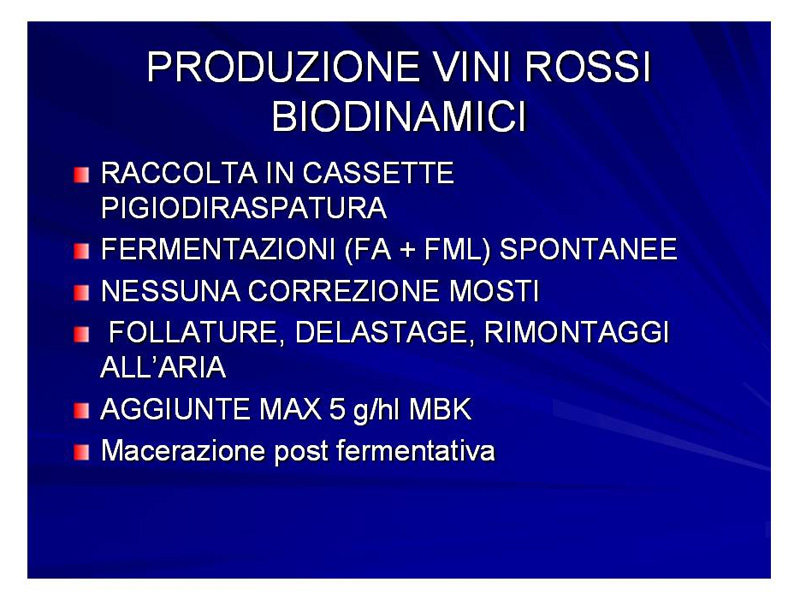
Figure 3
The practices employed are those for managing a rational process of excellence, aimed at best transforming the grapes. I will not dwell on the grapes or grape quality: this will be the topic of another conference where we will present the scientific work we have done in the last six to seven years.
Therefore, for this trial on Dolcetto, which I am about to discuss, we used grapes whose fermentation and aging were done in wood. The comparison was made over three years and the results are shown in Figure 4.
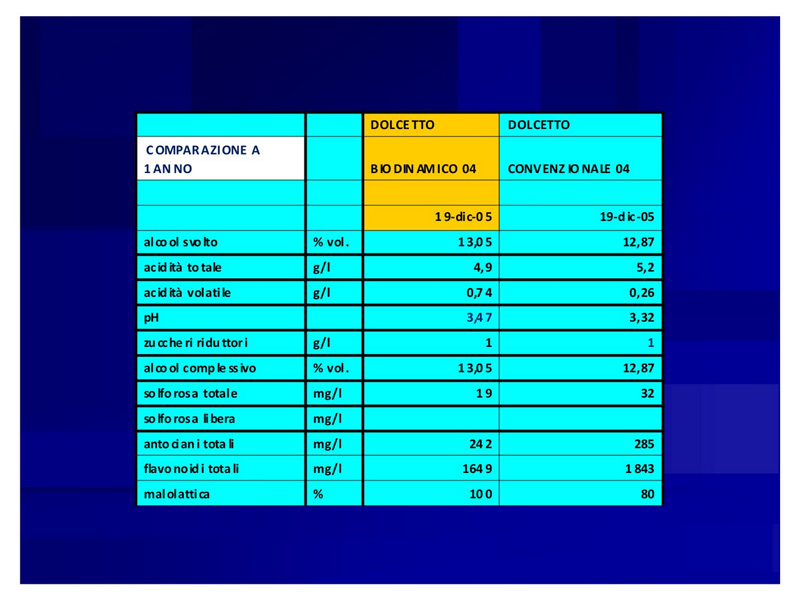
Figure 4
The analyses, carried out more than a year after racking, show that we are dealing with an “analytically correct” wine even in the case of the biodynamic “protocol.” This was the first trial in 2004.
Now, let’s go into the details of the following vintage, 2005, the second year of comparison between biodynamic and conventional methods at Casa Wallace winery in Cremolino (Alessandria Province).
The conventional protocol was defined by internationally accredited enologists and oenological laboratories, whom the winery commissioned to produce the best Dolcetto wine possible for the market, also assigning them to carry out all analytical surveys during the three-year trial period, as well as to organize an organoleptic evaluation.
All starting from biodynamic grapes, therefore working not in theoretical experimental conditions, but in practical cellar conditions with the goal of producing a wine for bottling. This is the conventional wine protocol.
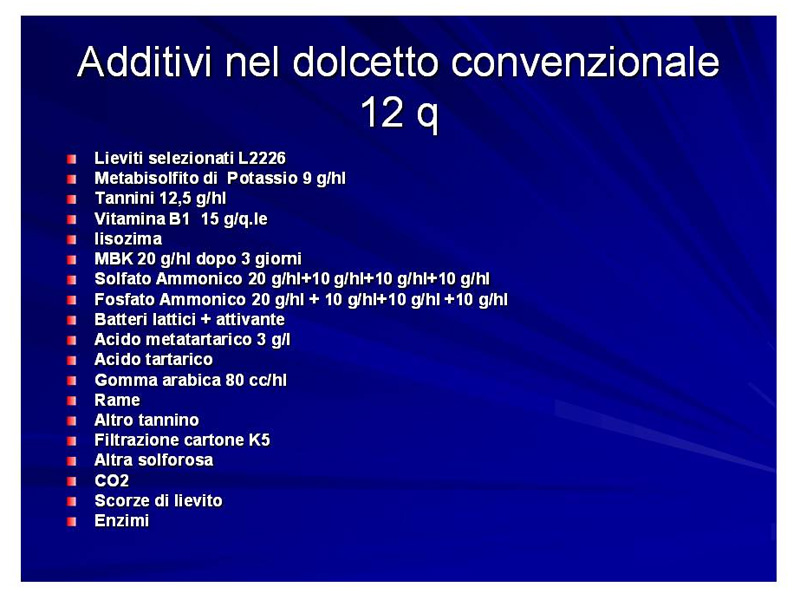
Figure 5
The biodynamic wine follows this protocol: potassium metabisulfite 4 g per hectoliter during fermentation and 4 g per hectoliter within one year.
You can already see a substantial difference between the number of substances added in a biodynamic protocol and in a conventional one. On one side, we have cutting-edge winemaking producing wines according to modern knowledge and practices; on the other side, biodynamic wines with reduced or no use of chemical additives and very basic technology. These biodynamic wines produced this way were among those you tasted today; among them was the Dolcetto we are discussing, so besides analytical parameters, you can directly compare your organoleptic parameters.
Everything normally used to make wine — selected yeasts, tannin, vitamins, ammonium sulfate, ammonium phosphate, lactic bacteria, metatartaric acid, tartaric acid, gum arabic, copper, CO₂, yeast hulls, and so on — was not used in the case of the biodynamic wine.
This was not done experimentally to prove something: this is simply how Dolcetto is made, the best Dolcetto that can be made. With this approach, our Dolcetto, undergoing spontaneous fermentation, had this evolution.
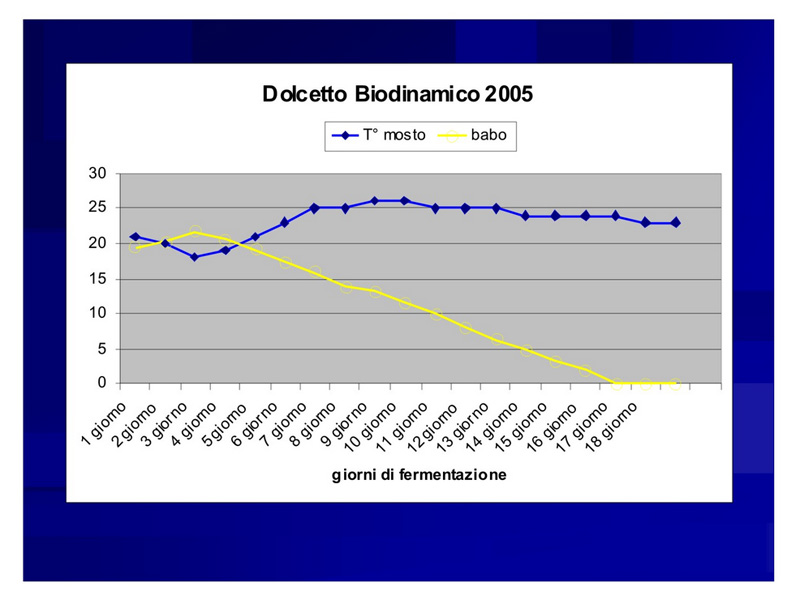
Figure 6
The evolution of the conventional Dolcetto is as follows.
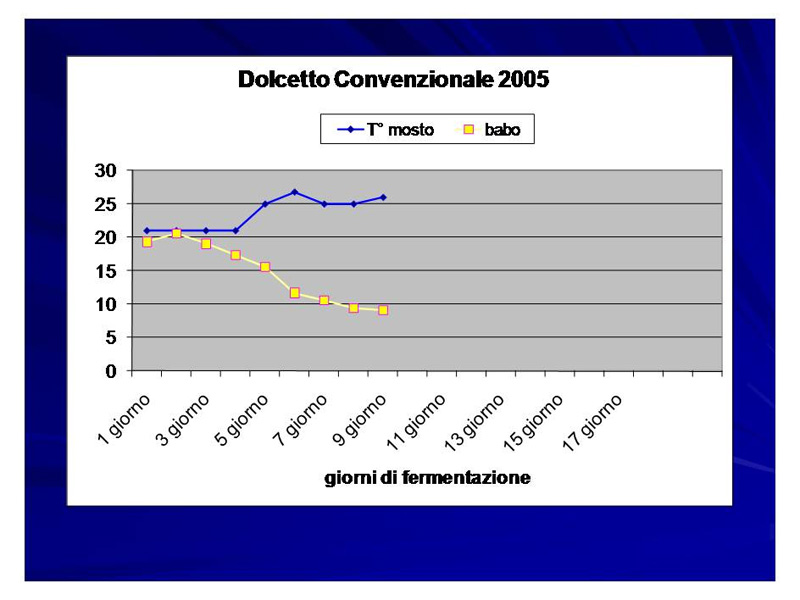
Figure 7
In Figures 6 and 7, you can see the progression of the must temperature and the Brix degree. The biodynamic vinification shows a continuous, steady fermentation with the must remaining on the skins well beyond the eighteenth day. In Figure 7, the process for the conventional Dolcetto is shown: at about 10 degrees Brix, the wine was racked off the skins. This racking was done warm, fearing reduction and color loss.
Basically, this early racking removes the skins and a large part of the wine’s components prematurely, and then attempts are made to reconstruct what was not extracted by adding yeast lees and other substances.
This is everything we have monitored analytically since September 23, 2005. Fermentation began on September 16 for both wines; the biodynamic wine was racked off on October 4. The table also includes analyses performed one year later (October 4, 2006).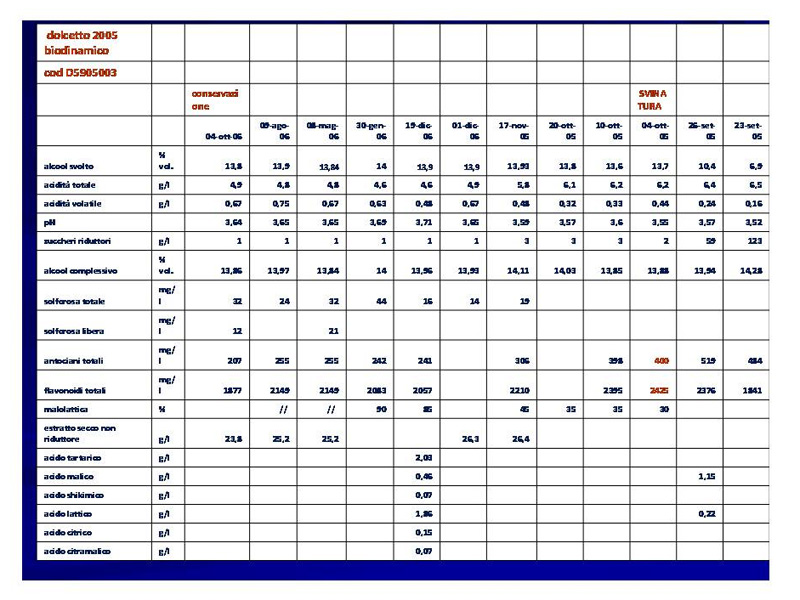
Figure 8
We racked off the biodynamic wine on October 4, while the conventional wine was racked off just 6 days after fermentation began, on September 22.
One year after racking, the data for the two wines were as follows:
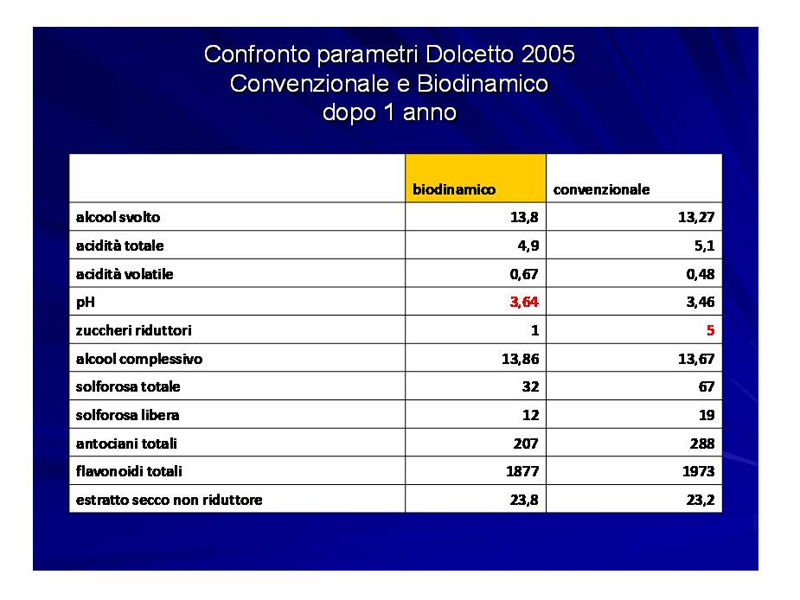
Figure 9
The total anthocyanin and total flavonoid levels stand out in the biodynamic wine with 207 mg/l and 1877 mg/l, respectively, while in the conventional wine—where substances capable of fixing the color were also added—the values are 288 mg/l for anthocyanins and 1973 mg/l for total flavonoids. You can see there is a very different pH: pH 3.64 in the biodynamic and pH 3.46 in the conventional, with greater pleasantness in the mouth with the biodynamic pH.
The residual sugar is intentionally 5 g/l in the conventional, while the biodynamic is dry. The first question we asked ourselves about the results—and many others did as well—was: was it really necessary to add all those substances to the conventional wine to achieve these results, which differ only slightly from the biodynamic and do not represent a qualitative improvement in the wine?
This is a fundamental point to start from. Why follow that protocol? To obtain a qualitatively better wine? Analytically, this was not demonstrated. So we went on to verify the organoleptic aspects.
Overall judgment after numerous tastings: the biodynamic Dolcetto has an intense aroma, is soft, and long; the conventional Dolcetto is poorly scented, astringent, rough, and short. Therefore, returning to the comparison, we fully applied our knowledge to the biodynamic grapes to obtain an excellent product. Those who applied the enological protocol did the best they could to obtain an excellent product from the biodynamic grape (considered excellent). The results are as shown, and any other comment is superfluous. Since 2007, all the company’s wine has been produced biodynamically. The wine tasted today was also evaluated by sector critics, and we report two reviews: the first by Luca Maroni who gave an overall rating of 88/100 with scores of 30 in balance, 30 in consistency, and 28 in integrity. We also report the judgment of Sandro Sangiorgi who says:
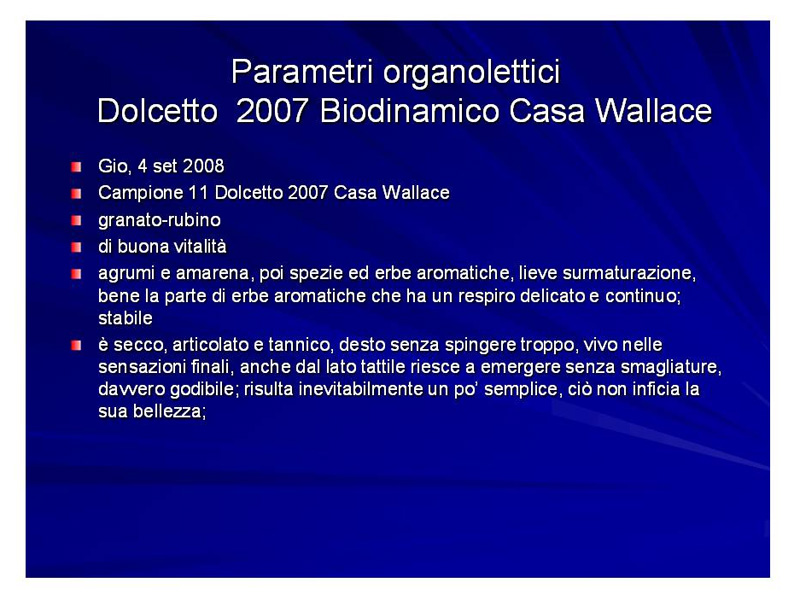
Figure 10
So we can say that biodynamic wine IS A WINE; a wine that can also hold up in a blind tasting against wines made with conventional enological protocols, and that does not need any justification about how it was produced in order to be enjoyed. There are many prejudices against biodynamic wine, and I hope that in the future, starting also from our decade-long experience, these can be overcome. Once it is proven that it is possible to produce an excellent biodynamic wine, it will be appropriate to engage in a comparison based on its organoleptic qualities.
On this occasion, many researchers from official science are present, and without any mutual prejudice, I invite them to use biodynamic grapes—which we are willing to provide—to repeat and deepen our experiments in order to validate or refute what we have stated.
Engaging in such a dialogue and reporting results here in Cerreto Guidi is one of our objectives. There are many prejudices about biodynamics and biodynamic wine.

Figure 11
Prejudices lead to the use of enological protocols aimed at avoiding what is shown in Figure 11. I cannot analyze all the parameters due to time constraints, but I want to spend a few words on spontaneous fermentation. Spontaneous fermentations are never responsible for “stuck” fermentations. Even in very difficult vintages, such as 2002 or 2003, no problems occurred.
Certainly, we need to clarify terms: spontaneous fermentation is not one that relies on the selection of pseudo-native yeasts that are added every year to the must, but rather the one performed with the yeasts naturally present mainly on that grape, in that place, every year. And furthermore: spontaneous fermentation does not mean an abandoned fermentation, but a guided one. We are the ones who “kick-start” the spontaneous fermentation when we decide. If terms are not misunderstood, it will be difficult to prove the contrary of what we have affirmed and demonstrated.
Another prejudice: the “horse sweat” smell, the phobia of Brettanomyces. A defective wine can have these off-odors, whether biodynamic or conventional; a well-made wine does not. We conduct many blind tastings: in at least two documented cases, the above defect was identified in renowned wines made with conventional protocols, and not in biodynamic wines, contrary to what most attendees had assumed.
So, we wanted to take a further step, on which we are still working, but I want to anticipate a preliminary finding in this direction. Since it was not the biodynamic wines that smelled like horse sweat, but the conventional ones that use a series of substances added that are foreign to the grape, we performed the following test. We vinified biodynamic cabernet sauvignon grapes in the same winery both conventionally and biodynamically. These were the results:
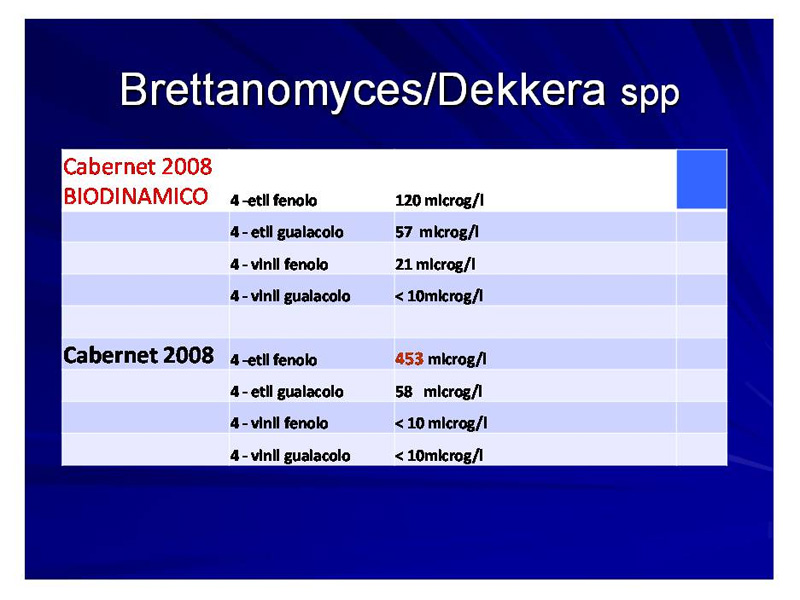
Figure 12
We tend to believe that the higher levels of 4-ethylphenol (an indicator of the presence of the incriminated microorganisms) found in the conventional wine come from the added tannin, but this is only a hypothesis that requires further investigation. For us, biodynamic wine is a wine that must be enjoyed without having to justify its flaws. This is indispensable. If it is defective, the flaw cannot be attributed to the fact that it is biodynamic, but to mistakes made during its production; no more and no less than what happens in many notably imperfect conventional wines.
We therefore reaffirm that it is possible to produce a biodynamic wine comparable to, and even superior to, conventional wine both in organoleptic and analytical parameters. A biodynamic wine can be produced without additives and without sophisticated technologies, without physicochemical correction interventions, except for the addition of small doses of potassium metabisulfite. We have not yet eliminated this last substance, unless we want to make imperfect wines. But we are talking about very low SO2 levels, ranging from 60 mg/l to 25 mg/l of total sulfur dioxide in the wines tasted.
I conclude with a study on Sangiovese, since we are in Tuscany. This is another work that you will find detailed in the proceedings of the Third International Sangiovese Symposium held in Florence in December 2008, entitled “Characteristics and Peculiarities of Sangiovese Wines from Three Areas of Tuscany, Obtained from Grapes Grown and Vinified According to Modern Biodynamic Techniques.”
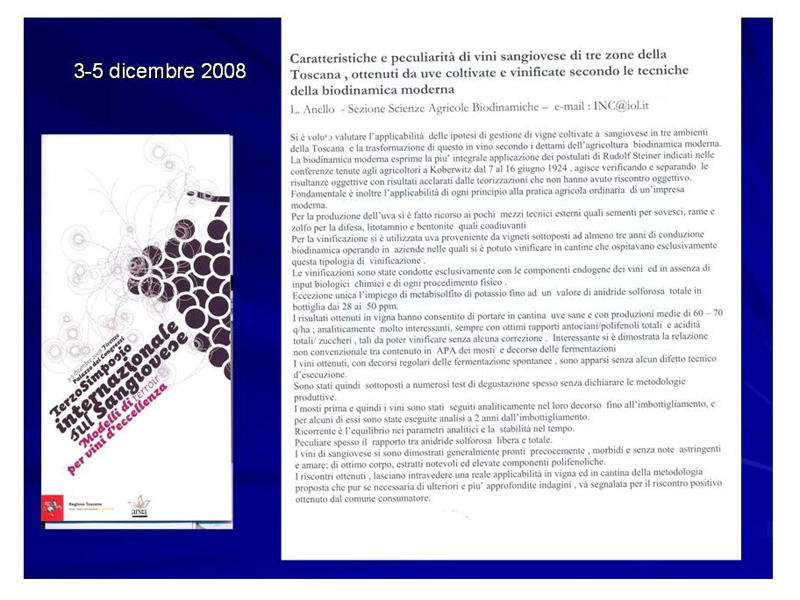
Figure 13
These are tests on Sangiovese conducted over three years in three different areas of Tuscany: Montalcino, Greve, and Montalbano. The studies were carried out in three well-established biodynamic farms. Through these studies, conducted using conventional scientific methods, we wanted to verify:
-
Is it possible to manage Sangiovese vineyards in Tuscany biodynamically, in an economically viable and qualitatively valid way?
-
Is it possible to vinify these grapes and obtain excellent wines by applying fully biodynamic “protocols”?
In the following figures, you will find concrete examples of how it is possible to produce wine biodynamically and how this results in a stable and highly valuable product.
These considerations, which are clearly evident to us after several years of positive results, still appear little recognized by the scientific community. These are the parameters of the Sangiovese wine produced in Greve in 2006, alongside the analytical parameters found in 2008.

Figure 14
These are the data for the Sangiovese from Montalbano, produced in 2005 and monitored through the analytical parameters in 2007.
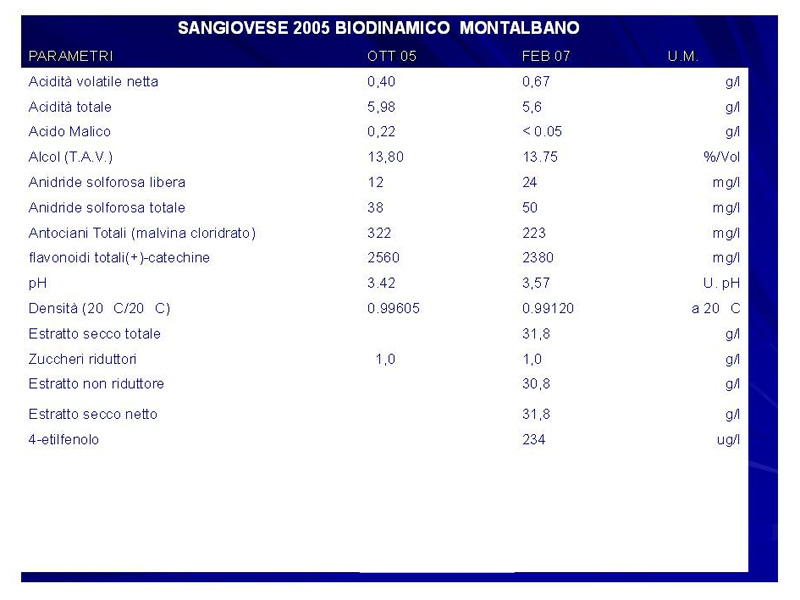
Figure 15
Finally, the data related to the 2005 Sangiovese produced in Montalcino.
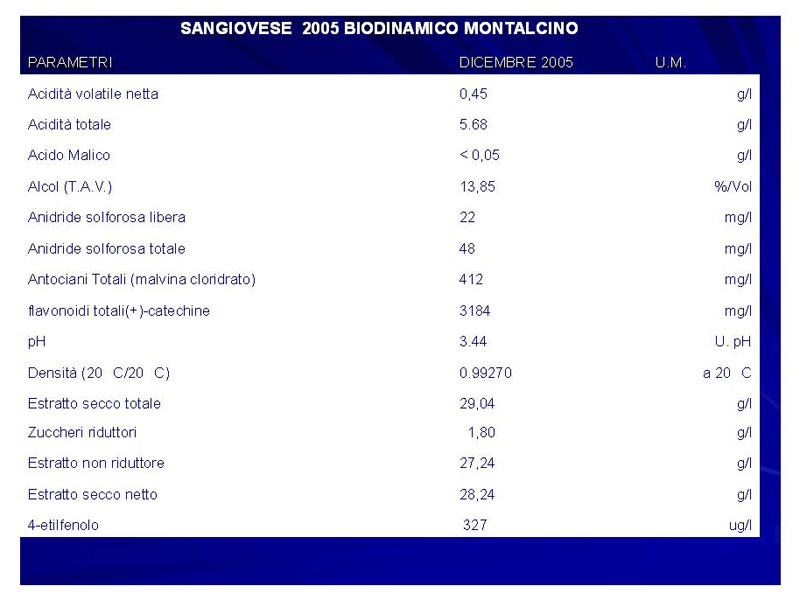
Figure 16
As clearly shown by the data presented, IT IS POSSIBLE TO PRODUCE BIODYNAMIC WINE. The analytical parameters describe products that meet expectations, do not confirm fears related to possible degenerations due to the non-application of materials and concepts typical of industrial enology (especially volatile acidity), and in some aspects show results so positive that they call for a reassessment of certain certainties in conventional enology itself (especially regarding total polyphenol content). We could discuss all this at length, but we will do so in other forums.
It is interesting, finally, to conclude by speaking about the tasting tests. Because the numbers are beautiful, but wine must be tasted.
Regarding organoleptic parameters, just one month after racking, these wines were submitted to the judgment of expert tasters and in all cases were judged free of technical defects, also highlighting what is shown in Figure 17.
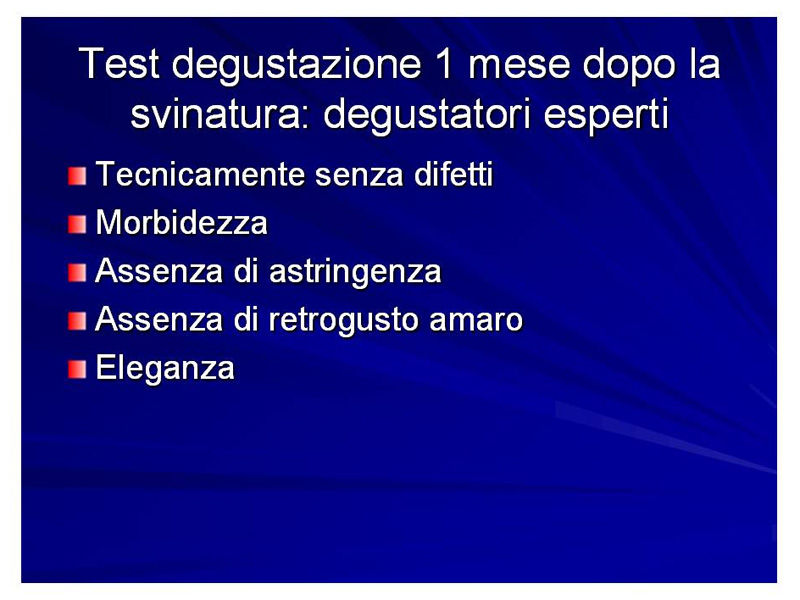
Figure 17
I will focus only on two comments: “very smooth” (we are talking about the Sangiovese at racking!) and “absence of astringency.” But how is this possible? We recorded sensations completely opposite to the two cornerstones on which the certainty of the need to age Sangiovese was built. The wines are “smooth and without astringency.”
“Absence of bitter aftertaste”: another cornerstone of Sangiovese put into question. “Elegance”—and no further comment is necessary.
Then we conducted a series of tastings with non-random tasters, that is, people attending our courses, so not professional tasters but attentive consumers (around 500 people in total). These are their impressions.

Figure 18
I just want to point out the “difficulty in recognizing Sangiovese.”
We then reflected and compared the evaluations of expert tasters with those of so-called non-random tasters. It clearly emerges that the usual descriptors of Sangiovese are being questioned, and that perhaps the codified and well-known taste attributed to Sangiovese may not actually be inherent to the grape variety but rather to the transformation technique.
This is something we need to reflect on. With modern biodynamics, we cultivate grapes in a way that is true to the expression of the territory: the vine nourishes itself from the land where it grows, exploring it with strong roots, receiving no fertilization or irrigation, suffering no pruning damage, actively participating in its own defense against pests, and we transform the grapes into wine with almost no chemical additives, no microbiological additions; we do not use physical treatments or sophisticated technology; thus we obtain a product, in our opinion and common sense, that expresses that territory.
The Sangiovese produced and transformed in this way is not recognized by the descriptors attributed to it by the “dominant literature.” Is it our fault, having certainly obtained a product of that territory and grape, or have the characterizations given to Sangiovese up to now simply been incorrect?
Is it possible that Sangiovese is never astringent at racking? Is it possible that Sangiovese is never bitter? Could it be that the CONVENTIONAL production technique—very invasive both in the vineyard and in the winery—defines those characteristics we traditionally attribute to Sangiovese?
These are the reflections I leave you with, and they surely deserve another dedicated conference.
2nd Conference – A Comparison of Scientific Paradigms
